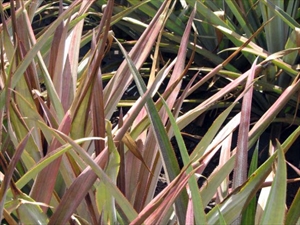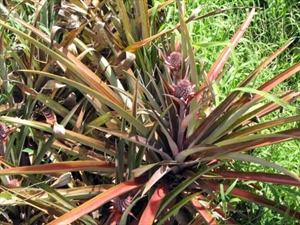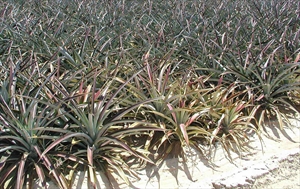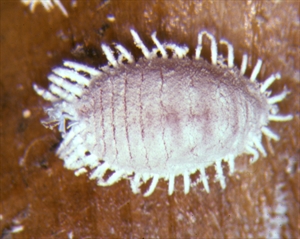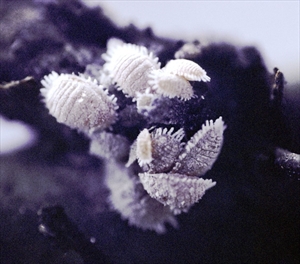Pineapple mealybug
Pacific Pests, Pathogens and Weeds - Online edition
Pacific Pests, Pathogens & Weeds
Pineapple mealybug (282)
Dysmicoccus brevipes. A closely related species, the grey pineapple mealybug, Dysmicoccus neobrevipes also occurs. Several viruses in the ampelovirus group are associated with pineapple mealybug wilt disease (see Fact Sheet no. 380), and are spread by these Dysmicoccus species.
Asia, Africa, North (Hawaii), South and Central America, the Caribbean, Europe (restricted), Oceania. Dysmicoccus brevipes is recorded from Australia, American Samoa, Cook Islands, Fiji, French Polynesia, Guam, Kiribati, Marshall Islands, New Caledonia, Niue, Northern Mariana Islands, Palau, Papua New Guinea, Samoa, Solomon Islands, Tokelau, Tonga, Tuvalu, Vanuatu, and Wallis & Futuna. Dysmicoccus neobrevipes is recorded from Fiji and Samoa. In Oceania, pineapple mealybug wilt disease has been reported from Australia, Cook Islands, Fiji, and the USA (Hawaii).
Wide; the mealybug infests more than 100 genera in more than 50 plant families. Waterhouse lists the following as the most important crops: banana, betel nut, coffee, groundnut (peanut), oil palm, Pandanus, pineapple, rice, sisal, soybean, sugarcane, and grasses and other weeds.
Damage is done by Dysmicoccus brevipes in three ways: directly (i) as they feed on the sap of the roots and lower (underground) stem and cause poor growth; and indirect by (ii) reducing photosynthesis - sooty moulds grow on their waste called honeydew that falls from the mealybugs onto the leaves and fruit, causing them to turn black; and, most importantly, (iii) spreading Pineapple mealybug wilt-associated virus(es), which causes pineapple mealybug wilt disease. Leaves on plants with pineapple wilt disease turn red, then pink, curl inwards and lose their stiffness, the roots die, and the plants collapse and rot (Photos 1-4). Fruit from infected plants are small. It is possible that several viruses are involved, and that both infection from viruses and feeding by mealybugs are needed for symptoms to develop.
Dysmicoccus brevipes reproduces without fertilisation, giving birth to about 250 living young. The first stage nymphs are called 'crawlers'. There are three moults over a period of 3-4 weeks before adults occur. The adults are about 2.5 mm long and 1 mm wide, oval, covered in a thick white wax, pink-orange beneath, with short waxy projections at the edge of the lower surface (Photos 5&6). This mealybug feeds and lives on the lower stem and roots.
Spread occurs as the crawlers move about by themselves or are carried from plant to plant by ants. They are also spread over longer distances on the wind and on the bodies of other animals. All the life stages are spread in consignments of fruit and propagating material traded nationally and internationally.
Dysmicoccus neobrevipes is similar except it is grey, not pink, and is found on aboveground parts of the plant, stem and roots.
Dysmicoccus brevipes and Dysmicoccus neobrevipes transmit Pineapple mealybug-associated wilt virus and that makes this a very important pest. The disease is a serious threat to pineapple production worldwide. In the Pacific, the disease has been reported from Cook Islands and Fiji.
Look for mealybug infestations on the roots, and stems beneath ground. Look for oval mealybugs, covered in white wax, but pinkish beneath. Look for short projections of waxy outgrowths around the edges of the body.
NATURAL ENEMIES
There are a large number of predators and parasitoids of Dysmicoccus brevipes, including ladybird (coccinellid) beetles, particularly Cryptolaemus species, and wasps (encyrtids). In many countries, biological control is effective when ants (Pheidole, Iridomyrmex and Solenopsis) are controlled.
QUARANTINE
Importation of pineapple plants for planting from countries where pineapple mealybug wilt disease occurs should not be permitted unless they are kept under observation in closed post-entry quarantine and tested for pineapple viruses (ampeloviruses and badnaviruses, in the Closteroviridae and Caulimoviridae families, respectively).
CULTURAL CONTROL
The control measures recommended below are for the control of the mealybug, and also for the control of Pineapple mealybug wilt-associated virus(es) that they are thought to spread.
Before planting:
- Use plants that have been treated to free them from virus (hot water or tissue culture) or selected from fields where the incidence of the wilt disease is low:
- Use plants grown from axillary or apical buds in tissue culture, and tested for the presence of Pineapple mealybug wilt-associated virus(es); OR
- Hot water treatment. Place crowns or slips in water at 50°C for 30 mins. This has been used as a treatment to produce planting material free from Pineapple mealybug wilt-associated virus(es); OR
- Use planting material from wilt-free areas or from fields where there is less than 10% of plants with the disease. Remove and destroy diseased plants before taking planting material. Additionally, do not take planting material from plants i) adjacent to those with pineapple mealybug wilt disease, or ii) that have recovered from symptoms.
- Do not plant new pineapple crops next to those where pineapple mealybug wilt disease occurs. Never plant pineapples on land where the disease was present previously. If crops are heavily infested, remove and burn them, and plough the land, leaving it fallow until all the debris has been plough in or has decomposed.
- Cultivate the soil to destroy colonies of the big-headed ant (Pheidole) as nests are near the soil surface, and re-invasion from surrounding areas is slow.
During growth:
- Remove plants with symptoms of pineapple mealybug wilt disease as soon as they are seen and burn them.
- Keep borders free from weeds that may harbour mealybugs and ants.
After harvest:
- Collect and burn all plant residues and, if practical, plough the land.
CHEMICAL CONTROL
- Dip crowns or slips in white oil or horticultural oil to rid the planting material of mealybugs.
- Use ant bait traps that are approved for use in pineapple to allow predators and parasitoids the opportunity to control the mealybugs naturally.
- If more than 3% of the plants have pineapple mealybug wilt (or mealybugs are common), use insecticides to control mealybugs and ants. Use diazinon or synthetic pyrethroids.
____________________
When using a pesticide, always wear protective clothing and follow the instructions on the product label, such as dosage, timing of application, and pre-harvest interval. Recommendations will vary with the crop and system of cultivation. Expert advice on the most appropriate pesticide to use should always be sought from local agricultural authorities.
AUTHOR Grahame Jackson
Information from Waterhouse DF (1998) Dysmicoccus brevipes. Biological control of insect pests: Southeast Asian prospects. ACIAR Monograph no. 51, 548 pp. Canberra; and CABI (2015) Dysmicoccus brevipes (pineapple mealybug). Crop Protection Compendium. (https://www.cabi.org/cpc/datasheet/20248); and from Subere CVQ et al. (2011) Transmission characteristics of pineapple mealybug wilt associated virus-2 by the grey pineapple mealybugs Dysmicoccus neobrevipes in Hawaii. Proceedings 7th International Pineapple Symposium. Eds.: Abdullah H et al. Acta Hort. 902, ISHS. (https://www.ishs.org/ishs-article/902_47). Photos 1&2 United States National Collection of Scale Insects Photographs, USDA Agriculture Research Service, Bugwood.org. Photos 3&4 United States National Collection of Scale Insects Photographs, USDA Agricultural Research Service, Bugwood.org. Photos 5&6 John Thomas, Department of Agriculture and Forestry, Queensland Government.
Produced with support from the Australian Centre for International Agricultural Research under project PC/2010/090: Strengthening integrated crop management research in the Pacific Islands in support of sustainable intensification of high-value crop production, implemented by the University of Queensland and the Secretariat of the Pacific Community.
